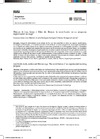Please use this identifier to cite or link to this item:
https://accedacris.ulpgc.es/handle/10553/59933
| DC Field | Value | Language |
|---|---|---|
| dc.contributor.author | Jover Maestre, Francisco Javier | en_US |
| dc.contributor.author | Rodríguez Rodríguez, Amelia del Carmen | en_US |
| dc.contributor.author | Torregrosa Gimenez, Palmira | en_US |
| dc.date.accessioned | 2019-12-19T16:34:22Z | - |
| dc.date.available | 2019-12-19T16:34:22Z | - |
| dc.date.issued | 2019 | en_US |
| dc.identifier.issn | 1131-6993 | en_US |
| dc.identifier.other | WoS | - |
| dc.identifier.uri | https://accedacris.ulpgc.es/handle/10553/59933 | - |
| dc.description.abstract | Although the so-called sickle blades are well known in all their morphological, technological and functional aspects, it was considered necessary to develop a new experimental archaeology program in order to validate some of the hypothesis raised up until now and delve into the study of the variables that condition the formation of use-wear marks in those tools. In this study, we have compared the traceological results obtained from the experimental program and from a varied set of sickle blades from different archaeological settlements in the eastern Iberian Peninsula. Among other conclusions it can be pointed out that these lithic pieces were used mainly attached to a handle in mowing activities. The lifespan of sickle blades in mowing is very long, up to several days of work. In addition, sickle teeth were not used as in current threshing sledges, inserted into large wooden boards | en_US |
| dc.description.abstract | Aunque los denominados como dientes de hoz son bien conocidos en todos sus aspectos morfológicos, tecnológicos y funcionales, se consideró necesario el desarrollo de un nuevo programa de arqueología experimental con el objetivo de validar algunas de las hipótesis hasta ahora planteadas en la bibliografía específica y profundizar en el estudio de las variables que condicionan la formación de los desgastes por uso en dichas piezas. Los resultados traceológicos obtenidos del programa experimental y de un variado conjunto de dientes de hoz procedentes de distintos asentamientos arqueológicos del este de la península Ibérica han sido comparados. Entre otras conclusiones se puede señalar que los dientes de hoz fueron usados, preferentemente, como armaduras de hoces en labores de siega. La vida útil de los dientes de hoz en labores de siega es muy amplia, alcanzado varias jornadas de trabajo y, además, no fueron empleados como los trillos actuales, insertados en grandes tablas de madera. | en_US |
| dc.language | spa | en_US |
| dc.relation.ispartof | Complutum | en_US |
| dc.source | Complutum [ISSN 1131-6993],v. 30 (1), p. 131-154 | en_US |
| dc.subject | 550405 Prehistoria | en_US |
| dc.subject.other | Dientes de hoz | en_US |
| dc.subject.other | Hoces | en_US |
| dc.subject.other | Agricultura de cereales | en_US |
| dc.subject.other | Edad del Bronce | en_US |
| dc.subject.other | Arqueología experimental | en_US |
| dc.subject.other | Sickle teeth | en_US |
| dc.subject.other | Sickle | en_US |
| dc.subject.other | Cereal Agriculture | en_US |
| dc.subject.other | Bronze Age | en_US |
| dc.subject.other | Experimental Archaeology | en_US |
| dc.title | Sickle teeth, Sickles and Bronze Age: The contribution of an Experimental Mowing Program | en_US |
| dc.title.alternative | Dientes de hoz, hoces y Edad del Bronce: la contribución de un programa experimental de siega | en_US |
| dc.type | info:eu-repo/semantics/Article | en_US |
| dc.type | Article | en_US |
| dc.identifier.doi | 10.5209/CMPL.64511 | |
| dc.identifier.scopus | 85072739729 | |
| dc.identifier.isi | 000478563600008 | - |
| dc.contributor.authorscopusid | 57209719288 | |
| dc.contributor.authorscopusid | 57211125105 | |
| dc.contributor.authorscopusid | 56896986900 | |
| dc.identifier.eissn | 1988-2327 | - |
| dc.description.lastpage | 154 | - |
| dc.identifier.issue | 1 | - |
| dc.description.firstpage | 131 | - |
| dc.relation.volume | 30 | - |
| dc.investigacion | Artes y Humanidades | en_US |
| dc.type2 | Artículo | en_US |
| dc.contributor.daisngid | 3300652 | |
| dc.contributor.daisngid | 33201732 | |
| dc.contributor.daisngid | 30612559 | |
| dc.contributor.wosstandard | WOS:Maestre, FJJ | |
| dc.contributor.wosstandard | WOS:Rodriguez, AR | |
| dc.contributor.wosstandard | WOS:Gimenez, PT | |
| dc.date.coverdate | 2019 | |
| dc.identifier.ulpgc | Sí | es |
| dc.description.sjr | 0,169 | |
| dc.description.sjrq | Q2 | |
| dc.description.ahci | AHCI | |
| dc.description.dialnetimpact | 0,0 | |
| dc.description.dialnetq | Q1 | |
| dc.description.dialnetd | D1 | |
| dc.description.erihplus | ERIH PLUS | |
| item.grantfulltext | open | - |
| item.fulltext | Con texto completo | - |
| crisitem.author.dept | GIR Investigación en Arqueología y Patrimonio | - |
| crisitem.author.dept | Departamento de Ciencias Históricas | - |
| crisitem.author.orcid | 0000-0001-7112-2441 | - |
| crisitem.author.parentorg | Departamento de Ciencias Históricas | - |
| crisitem.author.fullName | Rodríguez Rodríguez, Amelia Del Carmen | - |
| Appears in Collections: | Artículos | |
SCOPUSTM
Citations
2
checked on Jun 8, 2025
Page view(s)
87
checked on May 18, 2024
Download(s)
193
checked on May 18, 2024
Google ScholarTM
Check
Altmetric
Share
Export metadata
Items in accedaCRIS are protected by copyright, with all rights reserved, unless otherwise indicated.
